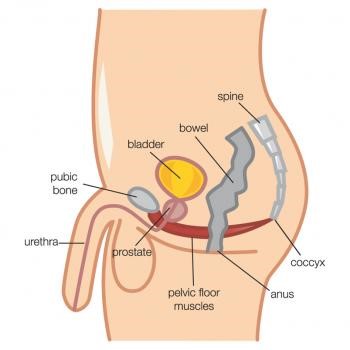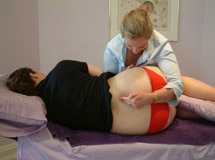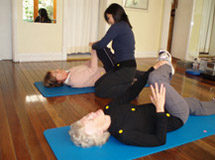Men’s continence and pelvic floor exercises

Men don’t talk about incontinence or erectile dysfunction easily, but problems can arise in pelvic floor muscle function as men get older and after prostate surgery. Research by Professor Paul Hodges has shown that prostate surgery may interfere with you normally control your flow of urine. Luckily his research has shown men have a series of other muscles which also control continence that we can teach you to use with specific exercises.
Recent research suggests that men will have a better outcome and less incontinence after prostate surgery if they learn how to turn their pelvic floor muscles on and then practice this exercise while also performing activites in the 2 to 3 weeks prior to surgery. At SSP Physio we have trained physios who can use the latest technology, Trans perineal ultrasound, to help you "see" when these muscles are working for you. That makes it much easier to then practice your pelvic floor exercises once you go home.
You will most likely need a few individual sessions of physiotherapy to learn how to activate the right muscles, but here are some guidelines that might help you re-activate your pelvic floor.
STEP 1: FINDING YOUR PELVIC FLOOR
- To start to feel where your pelvic floor muscles are, try sitting down with your hands under each buttock. Now roll your pelvis forward and back until you find your “sitz bones” and stay sitting so that your weight is directly onto your sitz bones. Your pelvic floor muscles stretch between these bones and forward to your pubic bone, and base of the scrotum.

STEP 2: HOW TO TURN YOUR PELVIC FLOOR ON
- You can do these exercises lying down, standing or sitting, so start with whatever position is comfortable for you. If standing or sitting, think tall rather than slouched. Relax your shoulders, relax your belly and let your bottom relax.
- To turn your pelvic floor muscles on, imagine you are stopping the flow of your urine. Another “image” you can try is ‘imagine shortening your penis’. If this doesn’t work, imagine you are walking into icy cold water and it has just reached the level of your testicles. Your normal response would be to draw your testicles up slightly. So now try to gently draw your testicles up without tightening your bottom.
- Which “Image” creates a gentle tension in your pelvic floor muscles? The lift in your pelvic floor will be gentle and feel like a slight tension at the front of your pelvis.
- Now relax and let all the muscles go loose so that your testicles drop and your belly softens. Being able to relax the muscles is as important as being able to turn them on.
STEP 3: DAILY EXERCISES FOR YOUR PELVIC FLOOR MUSCLES
- Using the “image” that worked best for you to turn your pelvic floor muscles on repeat your gentle contraction again, and this time see if you can hold it as you breathe in and breathe out.
- Once you can activate your pelvic floor gently, start with practicing a “set” of 8 to 15 lifts twice a day. See if you can maintain each pelvic floor contraction while you breathe in and out for 5 seconds.
- Allow yourself to let the muscles go completely for 3 seconds in between each contraction.
- Imagine someone is watching you as you do your exercises. Your face should look relaxed and they should not “see” that you are doing anything or moving your pelvis as you draw up your pelvic floor and breathe.
- You can progress your exercises by increasing the length of time you hold your pelvic floor contraction and by increasing to 4 sets a day. You could also try activating your pelvic floor and holding it on as you cough, or do 10 squats, or as you walk for short distances.
STEP 4: DO YOUR PELVIC FLOOR MUSCLE TRAINING WELL
A few good pelvic floor “lifts” will be better than lots of butt squeezes! If you are not sure that you are doing the pelvic floor contraction right, or if you do not notice a change in symptoms after 3 months, ask for help from your physiotherapist.
OTHER QUESTIONS ABOUT MENS HEALTH
Pelvic floor exercises and continence after prostate surgery
Immediately after surgery you will probably be catheterised. Do not try to do any pelvic floor exercises while the catheter is in.
Once the catheter is removed and you go to the toilet for the first time see if you can “find” the sense of stopping your urine flow. Don’t try too hard at this initially, but each time you go to the toilet in the first few days, see if it is possible to stop your urine flow mid-stream or at the end of going to the toilet.
In the first 3 weeks after surgery, after your catheter is removed, try to do 2 “sets” of your pelvic floor lift exercise, holding the contraction for 5 seconds each time.
Try to re-activate your pelvic floor and hold it each time you get out of a chair or out of bed, or try re-activating your pelvic floor when you cough or lift something if you have noticed any urine leakage performing these tasks.
Erectile problems
Erectile dysfunction is very common after prostate surgery. Men should ask their urologists for assistance if they are noticing erectile dysfunction, but pelvic floor muscle control may also assist you.
When to seek professional help
Like all exercises, pelvic floor exercises are most effective when individually tailored and checked to ensure they are done correctly. The exercises described on this site are only a guide and may not help if done incorrectly.
Please seek the help of your continence physiotherapist or GP if you are leaking urine at night or continuously through the day, or if you have pain when going to the toilet. You may also need a proper assessment of your pelvic floor function if you are still leaking urine during the day despite having performed the pelvic floor exercises described on this page for 4 weeks.
At Sydney Spine & Pelvis Centre we have physiotherapists who specialise in men’s continence and pelvic floor muscle exercises. They can assess your pelvic floor function and tailor an exercise program to meet your specific needs. They can also prescribe other treatment options such as Real Time Ultrasound biofeedback, plus discuss relevant lifestyle factors with you to improve your general exercise tolerance and performance. We also treat pelvic pain, pelvic dysfunction and pudendal neuralgia.




